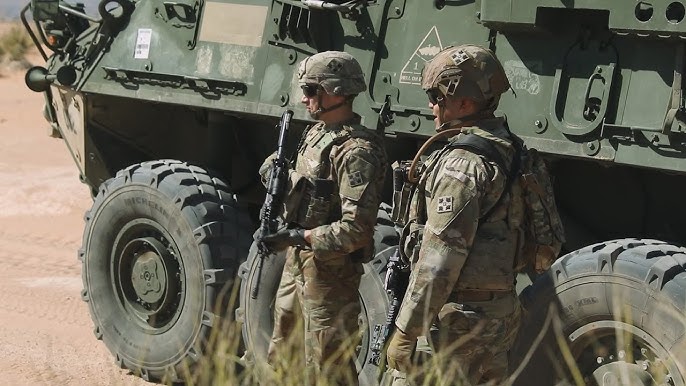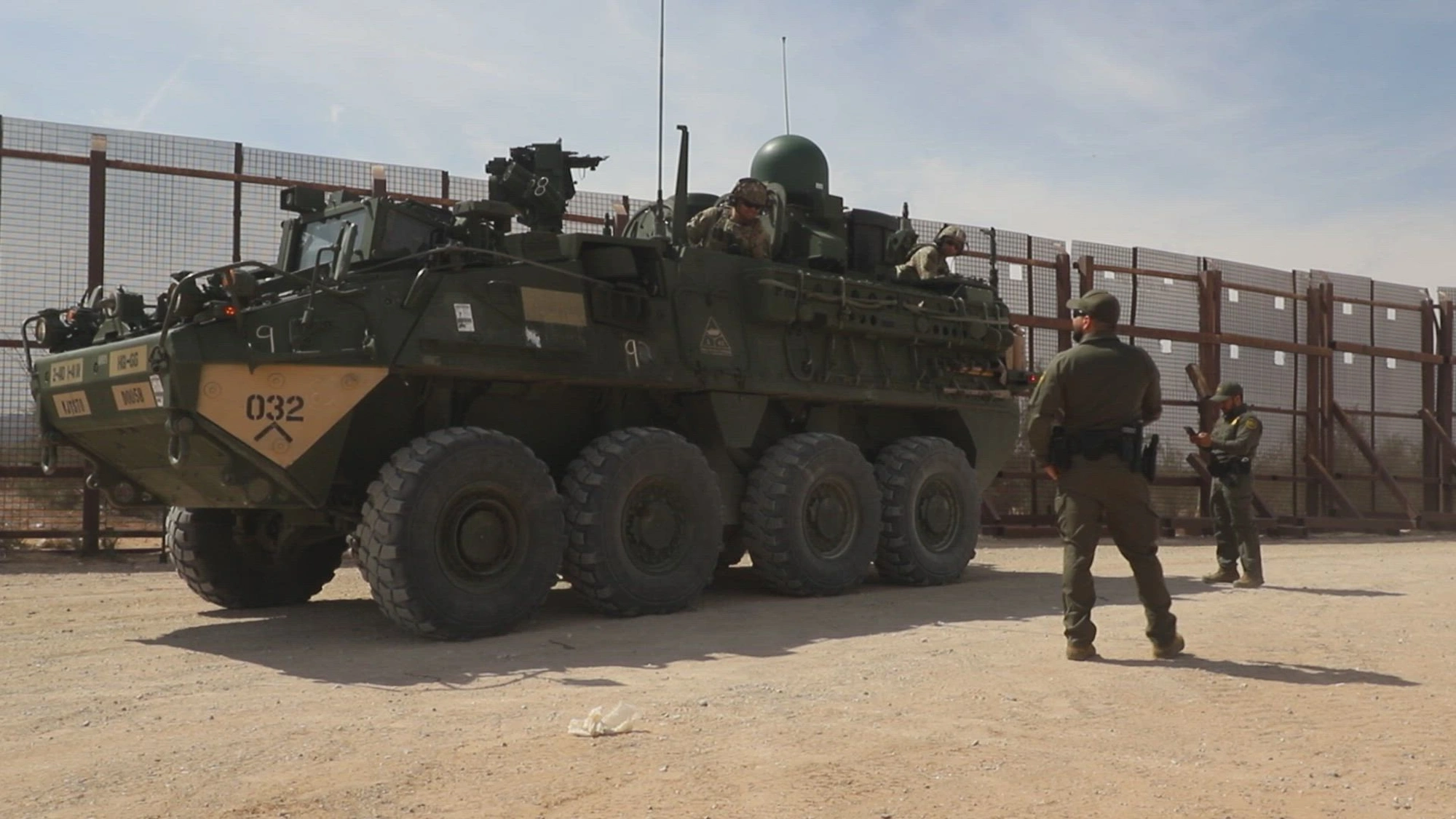Stryker Brigade Deployment at the U.S. Mexico Border
Overview
The sending of 2nd Stryker Brigade Combat Team to the southwest to meet the border security with the U.S. and Mexico in 2025 was a turning point of the strategy of the federal government to the border security issue.
The U.S.Mexico border was and is traditionally a responsibility of civilians and law enforcement, but with the shifting protection priorities in the national interests of the U.S., the location has become an avenue of increased military presence.
The presence of high-tech divisions like the Stryker Brigade is an indication of increased interest in hi-tech surveillance, high mobility and deterrence warfare.
In this article, we are going to be taking a look at the background of this deployment, its organization, its mission, the effects of this deployment and response of the larger population to this deployment in order to end up with a complete picture of just what this military movement is going to mean with regard to the future of the southern border.
Understanding the Stryker Brigade
Stryker Brigade Combat Team (SBCT) is the most mobile technologically advanced unit of the U.S. Army infantry. This brigade is named after Stryker armored vehicles and integrated speed, agility, and firepower.
Stryker vehicles are eight wheeled armored transports that have surveillance capabilities with combat capabilities. They are able to transport nine infantry troops and are generally fitted with weapon stations, cameras and communications systems.
The 2nd SBCT of the 4th Infantry Division at Fort Carson, Colorado, is recognized not only by its flexibility and fast deployment capability, but also due to its participation in the Iraqi and the Afghanistan wars.
Its troops are prepared to take up all kinds of missions, including war actions beyond the borders of the nation along with the support activities on the territory of the country, like response to the disasters and civil aid. This flexibility enabled the brigade, in 2025, to be a perfect candidate to fulfill a high-stakes mission on the southern border.
Deployment to the Southern Border
The U.S. Department of Defense permission was given in early 2025 to deploy 2nd SBCT, together with a General Support Aviation Battalion, to the U.S. Mexico border.
This was decided after increasing apprehensions regarding drug trafficking, human smuggling across borders, and activities involving cartels such as transportation of narcotic materials by the use of drones and to identify the patrol patterns of the U.S. soldiers.
They sent an estimated 2,400 soldiers of Stryker Brigade and 650 members of the aviation battalion. The deployment brought the total units of federal military personnel at the border to more than 9,000 including the National Guard troops and other supporting groups.
Although the reception of the military is not a new phenomenon on the border, the presence of a Stryker Brigade that is combat ready was different.

Roles and Responsibilities
Nevertheless, despite their military status, The soldiers sent at the border area were not set on direct law enforcement tasks. Such a limitation forms part of the Posse Comitatus Act, which limits the role of federal military personnel in law enforcement activities in the country.
Rather, Customs and Border Protection (CBP) was assisted by the Stryker Brigade through its surveillance of the border, exchange of intelligence, and aid in patrolling the unsuspecting places of the border.
The Stryker vehicles were also provided with superior camera systems that could record high-definition images during both day and night. Such systems enabled soldiers to be able to scan through large areas of the desert and rough terrains whereby normal surveillance would be impossible.
When there was suspicion, information was passed to CBP officers by the troops after which they carried out investigations or apprehensions.
Besides surveillance, the brigade has been doing routine patrols, situation awareness and logistical and medical support. The aviation battalion introduced helicopters and unmanned air assets and a bird view of the area besides optimizing surveillance of the border.
Operational Zones and Focus Areas
Areas covered by the deployment of Stryker Brigade along the border were including El Paso, Yuma, Big Bend, and South Texas. Both of these areas had their own problems. El Paso and Yuma both have a reputation of immense amounts of border crossings, Big Bend is remote and rugged, and as such, it is difficult to enforce the area.
Among the more prominent ones, in the Laredo sector, by the middle of 2025, about 100 soldiers, as well as 10 Stryker vehicles, were deployed. Their main task was to follow cartel drones at night. Although the number of crossings were rather low in the Laredo sector on a daily basis, it was a key point of entry since it was close to the main corridors of drug trafficking.
The forces worked mainly at night when they monitored illegal movements and air threats by the application of infrared imagery and low illumination technology. Their presence prevented a crime and also became more effective in enhancing situational awareness among the CBP.

Strategic and Political Implications
Active-duty combat troops on the U.S. Mexico border were not deployed without controversy either. According to those in support, this was an action needed to help fight transnational crime and enhance security of the area and prevent other illegal businesses like human trafficking and drugs distribution.
The deployment was interpreted as a demonstration of power stating that the United States was not afraid to employ whatever was available in its arsenal in safeguarding its borders.
However, the critics expressed concerns on the issue of militarization of the border and the confusion of boundaries between civilian law enforcement and military enforcement. Civil societies cautioned that this trend might interfere with civil liberties and the ease at which the military force would be employed in internal politics.
Parliamentarians criticized the price and utility of the operation and called to invest more money in immigration reform and technology or surveillance basis than boots up.
Other legal issues arose such as demarcation of the National Defense Areas in some areas of Texas and New Mexico. These areas were controlled by the military and afforded them greater activity but they also raised the dilemmas of property rights, the right of civilian entry and constitutional protection.
Troop Readiness and Conditions
Troops that were deployed were faced with challenges of the conditions in the southern border. Soldier endurance was put to test by harsh desert climates and extreme temperature conditions as well as the physical nature of the 24-hour operation needs.
However, military leadership considered this mission to be significant in promoting the country’s security agendas and defending the vital infrastructure.
One of the special training that troops had before being deployed included border law, coordination with other civilian agencies as well as when dealing with drone threats. There were regular briefings that made communication among the military, CBP agents and local law enforcement agencies quite clear.
Even under the adverse situation, the morale was high among the troops that considered the mission as a necessity. To several soldiers, the deployment became the first time they experienced any operational missions in the continental region of the United States.
It provided a good training concerning surveillance, coordination, and civil support and also sharpened their talents in addressing future missions.
Long-Term Implications
The Stryker Brigade that will be deployed in the year 2025 could be a roadmap of the future of the military participation at the border.
Although the deployment of combat forces in a domestic environment is frequently ripe with controversy, recent increases in asymmetric threats, including drones, human trafficking networks, cyber infiltration and others, have urged policymakers to reevaluate the paradigm of security.
The role of the military might in the long term be changed to collaboration in manufacturing and transferring technology to CBP and other organizations.
AI-powered surveillance with the usage of sensors, as well as unmanned systems, might lead to decreased reliance on the troop duties of large scale operations, preserving superior monitoring service.
Concurrently, both success and failure of the mission of Stryker Brigade would affect the attitude of the people and the political opinion regarding military engagement in future times.
In case the operation shows visible improvements, like more detections, quicker safety and enhanced collaboration, the approval in the population might increase.
In case it culminates in excesses, court battles, as well as minimal quantifiable results, then this might communicate a reconsideration of policy.
Conclusion
The 2025 launching of the 2 ndStryker Brigade Combat Team in the U.S. Mexico border was a historic moment on the changing scene of national security. It emphasized the growing functions of military instruments and forces in assisting border functioning as well as demonstrated a tactical switch to consolidated surveillance and deterrence tasks.






